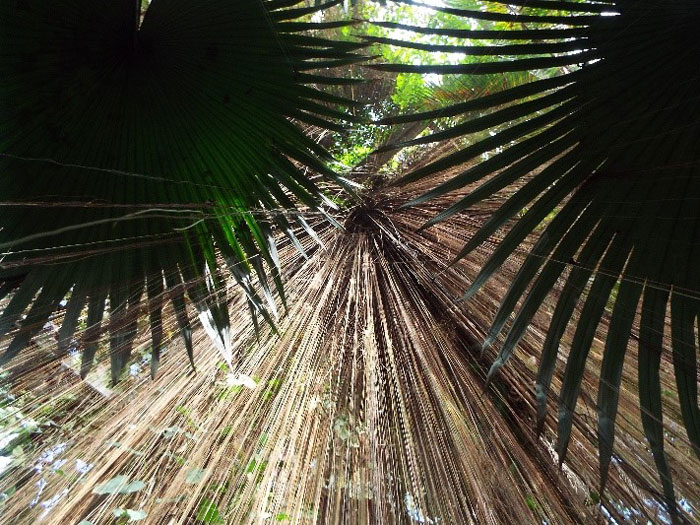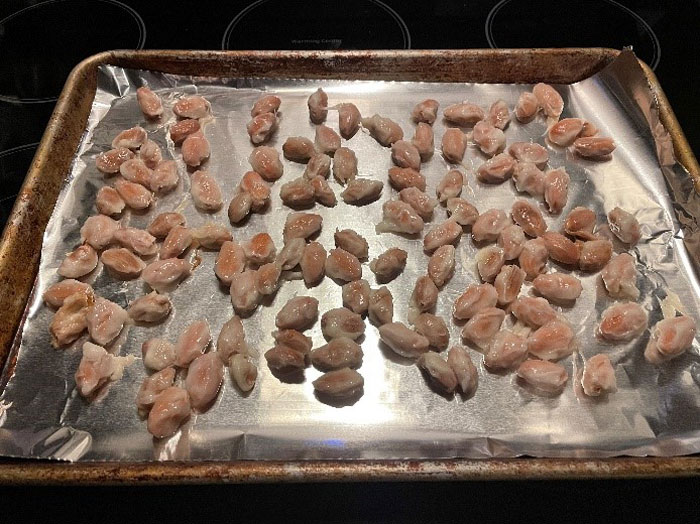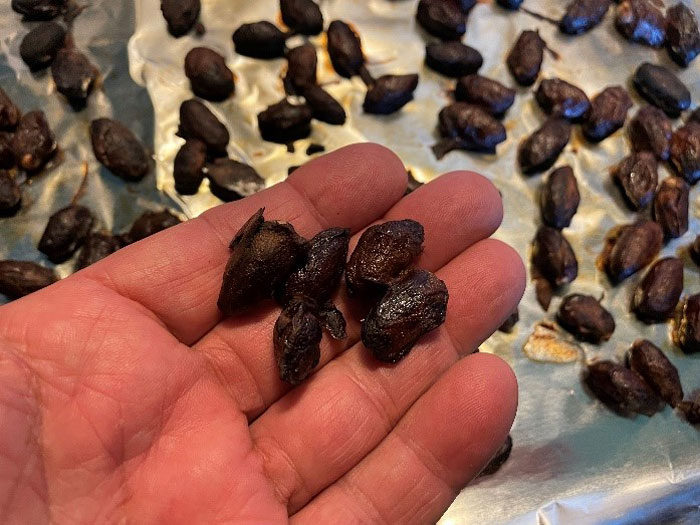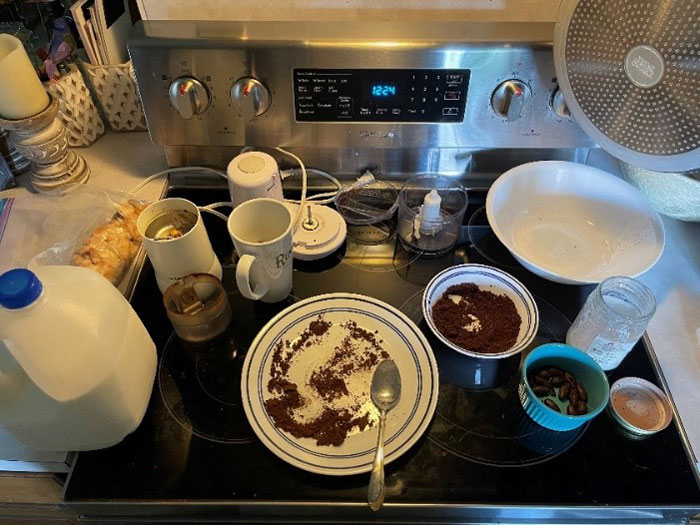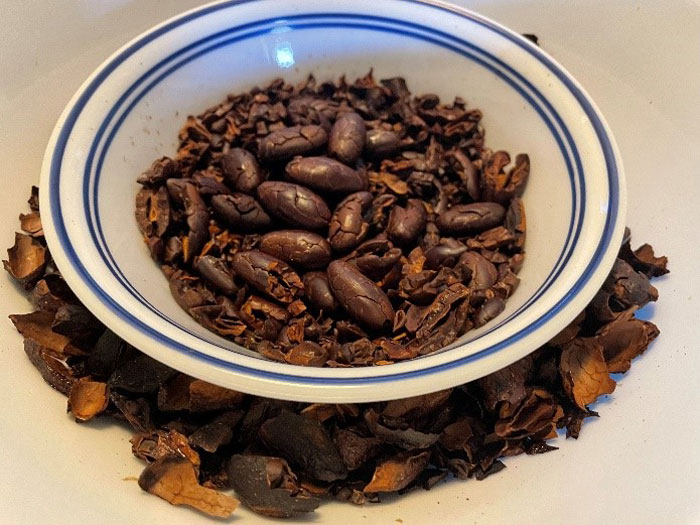Native Son: Hot For Chocolate
Dense fog slithers slowly through the steaming jungle, swallowing the sunlight and submerging the entire forest in a deep sweat of droplets. Birds and monkeys cry out from the boiling mist, never seen. Bees cling to the foliage, as the air is too fat for them to fly. Twigs snap all around … falling from a tree or underfoot of a beast? The hot air is thick, dense, almost foamy … leaving the taste of rotten peaches on the back of your tongue. Just overhead, an invisible rustle and a shower of wet leaves cascades down over you … and only then do you notice the serpents coiled at your feet. Your panicked dash ends quickly, as you run out of the fog and slide down a muddy embankment into a bizarre forest of small trees loaded with yellow, football-shaped fruits hanging right off the trunks. Soaked with sweat, slathered in mud, and peppered with blood-laced bites, you have arrived. You reach out and take a firm fruit in hand before chopping it off the tree with a machete. Minutes later, collection sack full of the sacred fruit, you try to remember the way back. A deep growl nearby — wild hog?…tapir?…jaguar?… any of which could leave you wounded or dead – and you go into a blind panic and scramble like a madman through the jungle. Half an hour later, you emerge … completely slimed and bleeding, but triumphant! Holding the sack of sacred fruits over your head, you howl like a wild beast back into the jungle. You have the treasure! You are actually holding the sacred Cacao fruits, source of the world’s favorite food: chocolate!
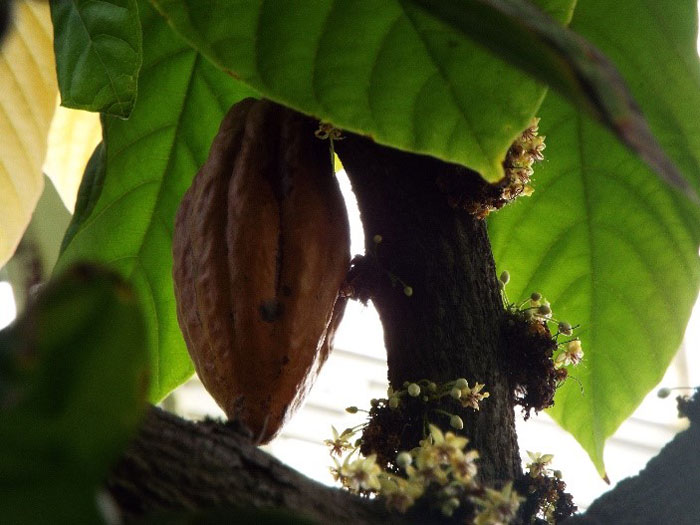

As for me, I just went to www.tropicalfruitbox.com to get mine. Delivered to my door in 48 hours, still chilled to keep those puppies fresh. God Bless America and the Internet.
The acquisition of fresh cacao fruit was an essential element to the Longview Arboretum’s recent “Chocolate Day.” We piled a bunch of folks into a room, and I spoke a minute or two on the history of cacao. (Well, actually, I tried to speak. All of the children in the room were quiet little angels, but I had that one chatty lady … and I didn’t have the heart to make her stand in the corner.) And so I give you … uninterrupted this time … a few highlights of cacao history.
Botanically known as Theobroma cacao, the cacao tree is native to roughly the northern third of South America and up into Mesoamerica.
The Olmecs were among the first to prepare drinks and gruels by fermenting, roasting, and grinding cacao beans (seeds). The Mayans followed suit, as did the Aztecs … and eventually everyone on Earth. But these pre-Columbian connoisseurs didn’t make chocolate. They made a spicy concoction of cacao and chiles, then added vanilla, magnolia, honey, and maize to taste, then colored it red with annatto seeds. —Interesting to note that many Internet sites touting “ancient Mayan” cacao recipes also include cinnamon, an Old World plant that was obviously unavailable to anyone in the New World at that time. (Let’s all say it together…”But it’s on the Internet, so it must be true.” Ugh…)
Sure, Europeans brought cacao back to their home countries, but it took them another 350 years to figure out how to make the first tasty chocolate bar (Geez, Louise, folks … sugar and butter). In 1875, a Swiss guy named Daniel Peter created the first milk chocolate bar. He had a neighbor by the name of Henri Nestlè … and you can guess the rest.
Most of the world’s cacao (60%) is grown in West Africa (Côte d’Ivoire and Ghana). Mine came from the next biggest producer, Ecuador (7%).
(Rather than do another 700 words on cacao history here, I figure you can just Google it yourself.)
Believe it or not, fresh cacao fruit is stunningly nutritious; in fact, it’s considered a superfood. Of course, by the time you process and pump it full of sugar … it’s not.
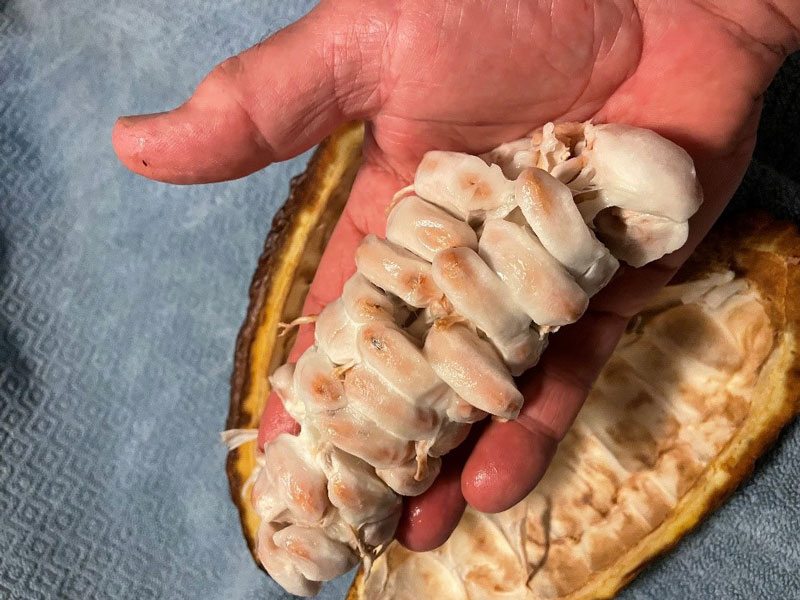
Back at Chocolate Day, I chopped some fruits open and let those who dared try some of the seeds. First off, the inch-long seeds are encased in a white, slimy/gooey substance called cocoa mucilage, the sight of which has been known to turn grown men into cowards. I readily admit that it looks funky, but it tastes great! Kind of an unexpected citrus twang to it. I quickly learned that the kids would try it if I said, “Slimy, but satisfying.” (A tip o’ the hat to Pumbaa.)
After sucking the mucilage off the seed, some folks like to just bite and eat the whole seed. Personally, I think it’s too bitter, but if you like nibbling on roasted coffee beans, you’d probably like cacao beans.
Much as I predicted, what everyone really wanted was for me to just shut up and let the ladies serve the chocolate, which was done with both style and panache. Longview Arboretum volunteers Maryann Hasty, Barbara McDaniels, and Tammy Moyes) and board member (Robin Maley) whipped out an impressive array of homemade chocolate desserts and everyone perked right up. I found it interesting … at first, people were trying to be all uptown and “Let’s explore our flavor palettes.” Ninety seconds later, it was like watching Cookie Monster shovel cookies into his mouth.
While I passed out a few fresh cacao fruits to attendees for their own home trials, I kept a few for my own culinary experimentation.
At home, I pulled the beans out of the fruit and made two piles; one for fresh experiments and one for fermented experiments. (Every resource said to ferment the beans, but I had my doubts.) I roasted the beans for about 1.5 hours at 300°F. The aroma of the fresh beans was amazing, almost intoxicating. The fermented beans were a bit musky smelling at first, but finished off quite nicely aromatic.
I then peeled the thin shells off the beans to have pure seeds. I have no idea how they do this commercially, but it took me two full length movies to peel them all. Ran the roasted seeds through a coffee grinder and…
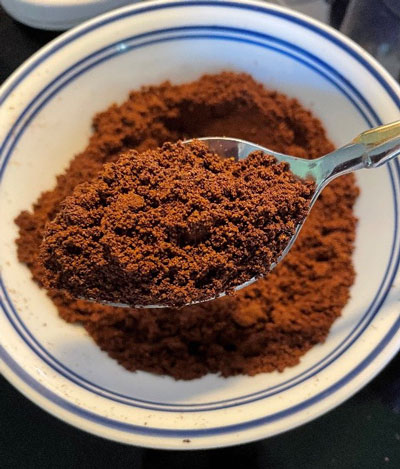
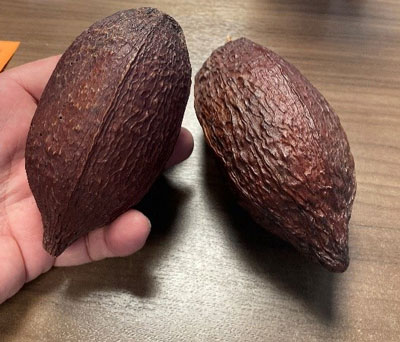
The Hot Cacao Drink Taste Test
Flavor ratings: 1-10: 10 = best.
Roasted, fresh (unfermented) cacao beans
Brewed in coffeemaker, the drink was very light in color (lighter than tea), but full of good chocolatey flavor-8. Added a dab of agave nectar … better-8.5. Then, a dash of vanilla … even better-9. Then, a dash of milk … best yet-10. Overall: 10—Most Excellent!
Aztec style: Starting with the coffeemaker drink, added a dash of chile (cayenne powder) and the chocolatey taste completely disappeared … blending with the chile to create its own unique flavor -8.5. (I said unique, so I can’t compare it to anything else, but it was excellent.) Funny thing, too, the cacao beans seem to neutralize the heat of the cayenne, so not too spicy hot. Dash of agave nectar … better-9. Dash of vanilla … better-9.5. Dash of milk … oh, that’s nasty. Overall: Excellent-9.5, just don’t add milk.
Fermented cacao beans
Brewed in coffeemaker, the drink was darker than the fresh beans, but did not taste even remotely as good as the fresh-4. Almost yuck. Agave nectar helped a little-5, as did the vanilla-6, but it was still kinda yucky. A shot of milk and a dash of butter seemed to bring the whole thing together into a decent flavor-8. Overall: okay, but not great.
Aztec style: Starting with the coffeemaker drink, added a dash of chile; complex flavor, but not very good-4. With agave nectar-5; vanilla-5.5; butter-maybe a little better -5.8. Dash of milk-are you kidding me? Overall: 6ish, and that’s being generous. (Just sipped the last of it … think I’ll lower that to an overall of 5…ish.)
The Results
Contrary to every single cacao recipe I looked at recommending fermenting the beans, I say no way. The fresh, unfermented cacao beans were far superior in flavor than the fermented beans. One caveat with all of this—There is a slight possibility (no more than 75-90%) that I may have messed up the fermentation process, rendering the whole taste trial essentially worthless.
Worthless? Ha! The opportunity to go all mad scientist and turn your kitchen into a science laboratory and make your whole house smell like the Hershey factory… priceless!
—
This little article is dedicated to my two favorite chocoholic friends, Kenneth and Marybeth Cranfill.
_______________________________________________________________
Just so you know … the Longview Arboretum & Nature Center is OPEN! Summer Hours (July 1 to September 1) are 7am-3pm, Wednesday through Saturday; Sunday 12 noon-5pm. Come out and see us! And bring your own brand of Zen! 903-212-2181 Longviewarboretum.org.
I need a road trip! Let me know if you’d like me to come and speak to your group sometime. I’m low maintenance, flexible, and you know I like to go just about anywhere. No city too big; no town too small. Just send me an e-mail at stevenchamblee@yahoo.com and we’ll work something out.

